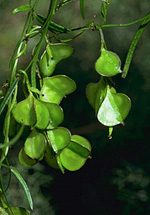 |
This is a moderate-sized, pantropical family. Dioscorea, the only genus in Australia, is found across the tropical north and east, from the Kimberley region of Western Australia to central coastal New South Wales, in rain forests and monsoon forests.
Characteristic features of the family Dioscoreaceae in Australia include: - robust annual-stemmed climbers perennating by tubers (yams) or woody rootstocks
- leaves simple, alternate, usually more or less heart-shaped at base and with prominent net-like venation between parallel main veins
- flowers small, with a single whorl of 6 white, cream or brown perianth
parts, usually unisexual (males and females on separate plants), in
axillary, often drooping, racemes or panicles
- fruit a winged capsule
Description
Evergreen woody or perennial herbaceous vines climbing by twining or scrambling stems. Perennating by tubers. Vegetative reproduction absent or by bulbils. Internal secretions not obvious. Plants glabrous or with simple, non-glandular hairs. Leaves alternate and spiral, or rarely opposite, petiolate. Stipule-like lobes and stipellae absent. Lamina simple or once compound, unifoliolate or palmate, symmetric; lamina/leaflets filiform, acicular, subulate, linear, lanceolate, ovate or elliptic; base rounded, cordate or hastate or sagittate; margins entire, ±flat; venation palmate, or parallel, with the midrib conspicuous or inconspicuous, and the tertiary venation reticulate; surfaces not punctate; herbaceous. Male and female flowers occurring on separate plants. Inflorescences axillary, consisting of spikes, racemes or panicles. Bracts present. Pollination by insects. Flowers sessile or stalked. Floral disc present; nectaries present on the perianth. Perianth regular, of 1 whorl only or 2 ±similar whorls, with 6 fused petaloid segments, valvate in bud, white, cream, grey, brown or black, without contrasting markings, membranous; claws absent; lobes ±entire. Fertile stamens 3 or 6, opposite to the outer or both perianth whorls, free or at least partly fused to the perianth segments, free of the ovary and style, distinct from each other, all ±equal. Staminodes present or absent. Anthers dorsifixed, not versatile, opening sideways by longitudinal slits; 2-celled. Ovary inferior. Carpels 3, fused; ovary with 3 locules. Style terminal, single and branched above or from the base. Ovules 2–numerous per locule, sessile; placentation axile. Fruit a dry, dehiscent loculicidal capsule; the perianth on the maturing fruit dry and persistent. Disseminule macro-surface winged, micro-surface ±smooth, brown, grey or black, dull. Seeds 6–numerous per fruit. Aril absent. Cotyledons 1–2. Embryo straight.
(Note: this description has been generated from the coded data compiled for the key. Any errors in the key data will be reflected in the descriptions.)
A treatment of the family Dioscoreaceae has been published in:
Flora of Australia 46: 196-202.
Australian genera of Dioscoreaceae (as recognised for the Flora of Australia)
Dioscorea

|
  |

Dioscorea hastifolia (fruits)
Photo: M.Fagg © ANBG

Dioscorea hastifolia (male flowers)
Photo: A.S.George © A.S.George

Dioscorea transversa (flowers)
Photo: M.Fagg © M.Fagg

Dioscorea transversa (fruits)
Photo: D.Greig © ANBG

|
 |
|